Family : Upupidae

Text © Dr Davide Guadagnini

English translation by Mario Beltramini
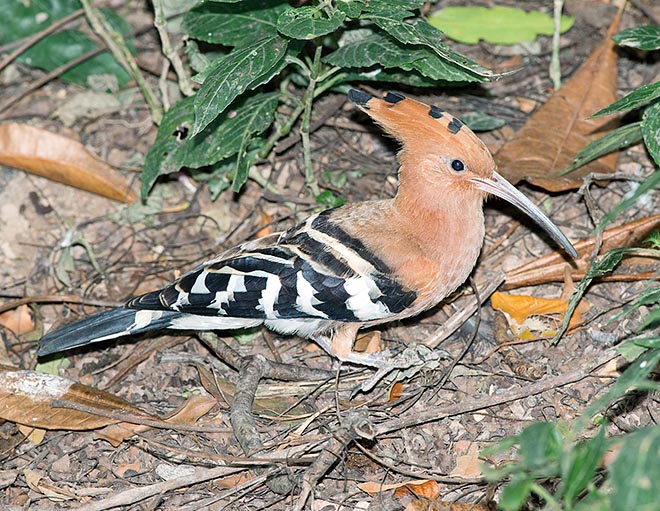
Migrant, with 9 subspecies, Upupa epops has an Euro-Asian/African distribution © Giuseppe Mazza
Another species of hoopoe, the Giant hoopoe (Upupa antaios) went extinct because of man during the sixteenth century; it was the biggest bird, apterous and endemic to Saint Helena Island where it nourished of mainly of an insect, the Saint Helena giant earwig called also Saint Helena earwig (Labidura herculeana), which, in turn, went probably extinct always due to the introduction of alien species.
The classification of this species has been object of variations: traditionally, in the past, it was inserted in the order of the Coraciiforms (Coraciiformes), but some taxonomists have proposed to place it in a specific order, that of the Upupiforms (Upupiformes).
Of the hoopoe are recognized various forms and subspecies that slightly differentiate for size and tonalities of the livery; presently the recognized subspecies are nine:
Upupa epops epops, the nominal subspecies, diffused in a very vast territory, from Madeira through most of Europe up to China, North Africa, Middle East, Central Asia and part of India.
Upupa epops africana, subspecies of central-southern Africa; in comparison with the described nominal has a stronger reddish colouration.
Upupa epops major, present in north-eastern Africa; compared to the nominal is bigger, with robust and long beak, with thinner caudal bands and evident white alar ones, with more greyish-duller colouration (with the nominal has an overlapped range in Libya and part of Egypt).
Upupa epops senegalensis, distributed from Senegal to the Horn of Africa; smaller and with stubby wings in respect to the nominal.
Upupa epops waibeli, distributed from Cameroon to Kenya; similar to the subspecies senegalensis but little bigger, darker and with more marked white alar bars.
Upupa epops marginata, subspecies endemic to Madagascar; is bigger, with duller colouration and less white on wings and tail in respect to the nearby African subspecies.
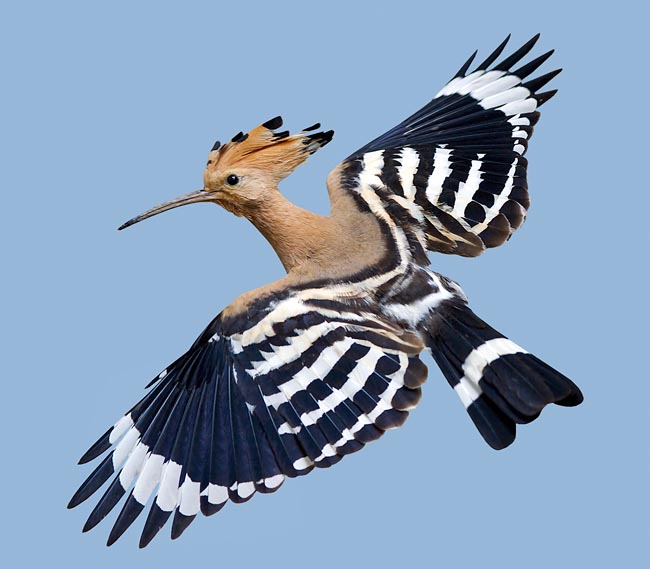
Shy and reserved, is noted only when scared flies off fluttering © Gianfranco Colombo
Upupa epops longirostris, diffu- sed in south-eastern Asia up to the western part of Sumatra; bigger and paler tonalities than the nominal (it shares with the nominal the north-western parts of its own range).
Upupa epops saturata, present in Siberia, Tibet, China and Japan; paler livery than the nominal one (with which overlaps in the western zone of its range). After some authors the subspecies might even be more numerous and some of them should be raised to the level of independent species.
The name of this splendid bird comes from the Latin and is the onomatopoeia of the cry, mainly emitted by the males during the reproductive period, and that is a recognizable tri-syllabic hup-hup-hup. “Upupa” is the Latin name of this bird, whilst “épops” is the name of the same in Greek.
Zoogeography
It is a migrant species with Euro-Asian/African distribution (most of the Palearctic and Afro-Tropical area), sedentary in the warm zones of its own habitat.
It nidifies in north-western and sub-Saharan Africa, central, south-western Asia (eastward, up to Japan), Europe up to southern Sweden (excluding, even if not in a rigid way and with some return, the British islands, the Netherlands and most of Scandinavia). Errant specimens have been reported also out from the vast typical range. It migrates and hibernates mainly in India, and Tropical Africa. In Italy is summer nesting as well as passing by in March-April and September-October; present almost everywhere (but the Alpine arc and the highest Apennines). It loves plain and hill habitats, preferably up to 800 m of altitude with peaks of presence up to 3000 m.
Ecology-Habitat
The best habitat consists in wooded countryside, small woods with clearings, olive groves, vineyards, orchards, fields extensively and variously cultivated, edges of woods and rural and hilly locations with vast open spaces and usually little urbanized even if it adapts to a cohabitation, but not too strict, with the man. It frequents also the savannah and the steppe. It loves the rather dry ecosystems with trees, masonries and suitable sites where to nest. The species is sedentary in the ranges with warm climate (tropical and subtropical) although it may perform movements linked to the climatic variations.
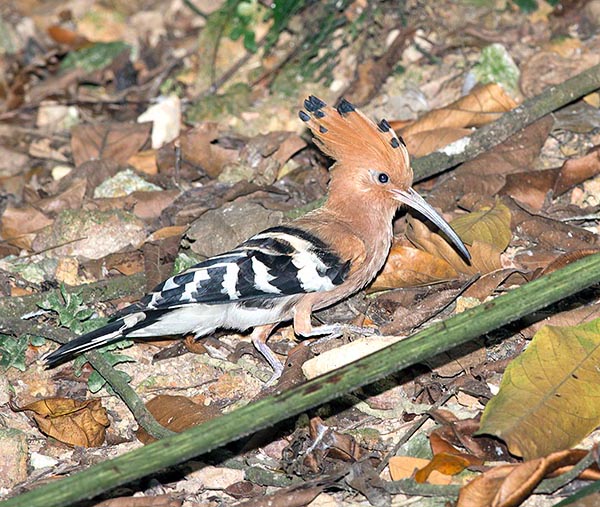
It spends the day looking for insects, integrating the diet with small invertebrates, seeds and berries © Giuseppe Mazza
The hoopoe, thanks to its colouration, to some morphological characteristics and to the vocalizations emitted is very difficult to be mistaken with other species. It is medium-small, has a structure of frail and light appearance, with a total length of about 27 cm (25-32 cm), the tail is about 9,8-10,9 cm long.
The colouration of the sexes is practically the same, but the males are slightly bigger: 140-153 mm wing in the male and 136-148 mm in the female; length of the beak 53-63 mm in the male and 50-58 mm in the female; medium weight of 67-68 g the male and 51-58 g the female (with extremes between the 45 and the 90 g).
The sedentary populations tend to be smaller and to have a more slender shape than the migrant ones.
It has an abundant, and quite long, tuft of erectable feathers on the head that form one of the distinctive characters of the species. Overall, the livery presents a group of three contrasting and promptly identificatory colours: orange-pinkish-slightly brown, white and black. The head, the tuft, the neck and the upper mantle are orange-brown-pinkish; the extremities of the feathers of the tuft have black tips. The lower mantle goes from the orange brown to the greyish brown; the back and the scapular feathers are widely barred of black alternated with white-cream. The rump is white. It has fairly wide and rounded wings. The feathers of the wings are black with a wide white band through the second and the eighth remex; incomplete bands and spots, always white, are present on the other remiges which, in the whole, form a white alar band on black base; secondary feathers with similar colouration forming the continuation of the white alar band. The primary coverts of the wings are glossy black; the bigger and the medium ones are glossy black with white-cream bands forming white and black stripes on the wing; the lesser upper coverts are brown-orange-pinkish, the lower ones are black with white-cream apices. The chin, the throat and the chest are orange with vinous-pinkish suffusions; the feathers of the chin are edged white.
The hips and the sides of the abdomen are whitish striated of dark brown. The centre of the abdomen and the under-tail are white. The axillar feathers are orange-pale pink; the under-wing whitish with orange-pink nuance and with black apices on the lower coverts. The upper coverts of the tail are black, the upper ones with white apices and bases. The rectrices are black with a median white belt; the outer ones are edged white. The number, the shape and the size of the lines and of the white spots of the wings and of the tail vary depending on the subspecies, population and, in lesser way, individually; the same can be said for the orange-brownish-rust or greyish tonalities of the livery (the variations are also liked to the diet).
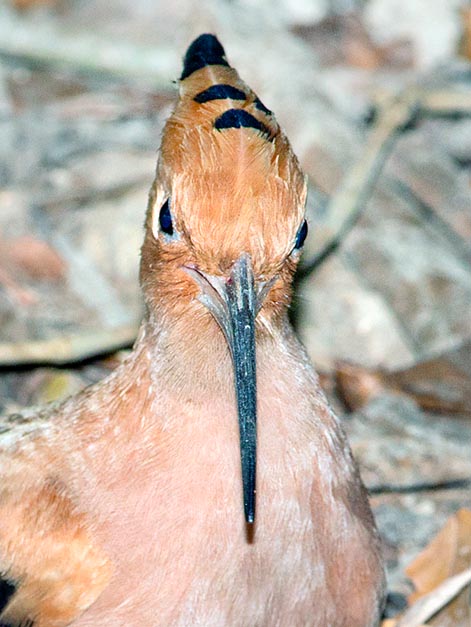
The long beak allows to find and extract larvae and earthworms © Giuseppe Mazza
The paw has three fingers bent ahead and one bent back (posterior finger, rather long); the middle finger and the outer one are partially merged only at the base, remaining completely free. The paws are slate grey with possible fleshy hues.
The eyes are rather small and round with brown-dark iris. The female is similar to the male and is difficult to distinguish: throat, face and chin are less orange-pink and browner, the feathers of the chin are whiter edged. Also the juveniles have a livery similar to the adults: more similar to the adult females, without the vinous-pinkish tonalities, general look more “dusty” and less glossy, shorter beak, straight and with buccal base more expanded and white-yellowish.
Ethology-Reproductive Biology
The hoopoe is a bird of secretive and shy habits contrasting with the evident coloured livery: in fact it is a bird difficult to be seen if not at the last moment, when flies away scared and the moving colours “hit” suddenly the observer.
Though rather reserved and silent also during the reproductive period, the hoopoe emits some quite typical and recognizable vocalizations, a soft and low “hup-hup-hup”, a low “caa-caa-caa” and “pu-pu-pu”; furthermore, if scared, emits vocalizations similar to meows and to corvid crackling cries.
It has a light way of flying, with wind beats regularly spaced, flickering, waving, rather slow and evident; showy due to the movements of colours evidenced by the movement of the wings. This type of flight does not does not prevent the bird to effect sudden and fast movements in case of potential danger. The hoopoe perches on branches and on the walls, vertically at times as the woodpeckers do.
The hoopoe is an insectivorous bird as it mainly nourishes of insects and their larvae, spiders and myriapoda, but it completes the diet with earthworms, molluscs and small vertebrates such as small lizards, small amphibians, at times eggs and small birds found in nests done on the ground. The main dish is formed by coleopterans, larvae, caterpillars, chrysalises, orthopterans and ants. This ample carnivorous diet can be slightly integrated with few vegetal essences (seeds, berries). It eats preferably on the ground where it walks and runs moving the head forward and back in a characteristic way exploring the land and the various substrata with the beak and eventually digging with the paws. More rarely, it hunts insects while flying. The big preys, and particularly hard, are beaten against the ground or against rigid surfaces or thrown in the air and picked up to be torn apart or to be devoided of the particularly chitinous parts.
It has mainly diurnal habits and is more active during the warm afternoon hours during which spends long time looking for food. When restless or excited, it raises the nuchal tuft. This bird loves to “bathe” in the sand (for getting rid of possible ectoparasites) and in the sun. It carries on a solitary life, in pair or in very small flocks.
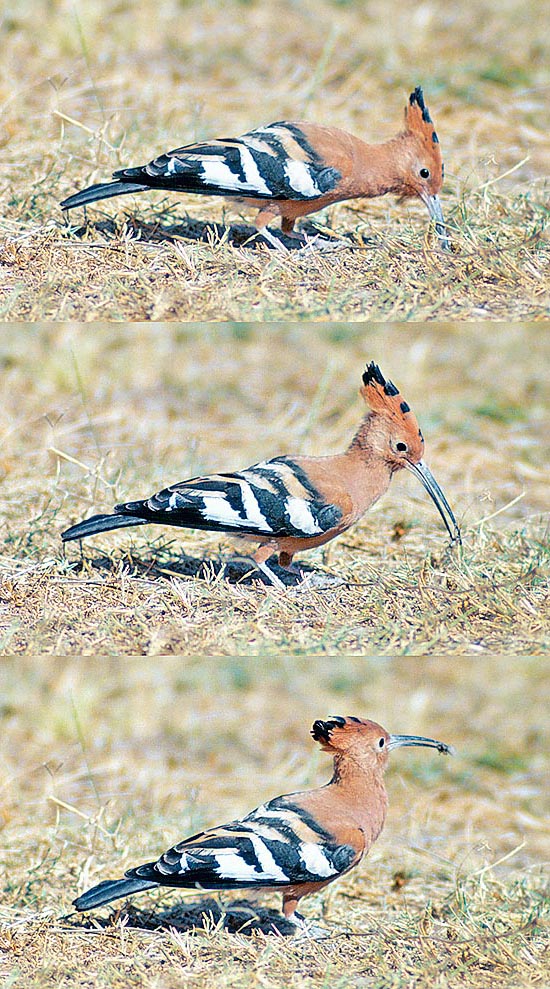
Here she is at work, in the African savannah, careless of heat, happy with the prey in its beak © Giuseppe Mazza
The male courts the female by chasing her with erect tuft and raised feathers of the throat, often offering food gifts. It usually copulates on the ground.
The pairs of hoopoes are quite territorial and are squabbly with possible intruders of the own species, which they do not hesitate to attack. The nests are realized in hollows of various types from the level of the ground up to some metres from the same, are ok cavities in the trunks of the trees, nests dug by other birds, cavities and fissures between the roots and in the walls, various interstices and artificial nest boxes. The nest can be absolutely not, or scarcely, padded with some vegetal material.
The female in reproduction and the nestlings have the glands of the uropygium particularly developed and working; in this period the secretion is abundant, blackish and with a disgusting smell having the function of keeping away possible intruders from the nest as well as of having a probable antiparasitic function. Probably, due to this smell coming from the nests, this is why the hoopoes were considered as dirty birds, actually, the females try to eliminate part of the droppings of the progeny keeping the nest clean.
Usually, are spawned, from late April to June, 5-8 (12, with more eggs spawned at higher latitudes and less in the tropical zones) eggs which are incubated by the female for about 15-18 days. During the hatching the male takes care of her nourishment.
The eggs are whitish-grey or pale olive or pale bluish-light blue, with average size of 25,9 per 17,9 mm; the average weight of the egg is of 4,5 g and of the shell of 0,35 g. The newborn, nidicolous, is pink when just born with sparse and long white down. The mouth inside is bright pink with external big buccal margins, protruding and of white-wax colour. In the young, the beak is slate bluish.
Since small, the nestlings can emit cries similar to hisses for discouraging possible “nesting” predators and a sort of “chirps” when asking to be nourished by the parents. The chicks are fed initially by the female (for the first 10-15 days) with the food given to her by the male; then, when a little older, they are fed directly by both parents till the age of the flying off happening when about 20-28 days old.
Out of the nest, the young hoopoes are still nourished for about one week or a little more. The young, in case of danger, can assume defence-menace postures widening the tuft, opening the beak and the wings, assuming serpentiform movements, raising the tail and spraying the faeces at a distance against the possible foe. Replacement hatchings, in case of precocious loss, can occur. At times, are done successfully two hatchings per year (in the tropical areas).
The hoopoe, quite common in its range, has begun to get a decline in some zones starting from the second half of the XX century due to the use of pesticides and to the modification of the suitable habitats; it has disappeared from some European regions even if the global European population is good (around the two millions of specimens).
Luckily, the hoopoe is widely appreciated for its elegant beauty and for the fact of being a bird useful for the agriculture as it nourishes of particularly annoying insects such as the Pine processionary (Thaumetopoea pityocampa) which is predated when at the stage of chrysalis.
Due to their peculiar look and the characteristic vocalizations, this bird has found ample space (both positive and negative) in the mythology, in history, in art, in the ancient scriptures, in the symbology and in the comedy. The hoopoe s the national bird of the nation of Israel, is well present in philately and in heraldry (also thanks to the regal crown of nuchal feathers). It is the symbol of the state of Punjab and of associations dealing with animal and habitat welfare.
